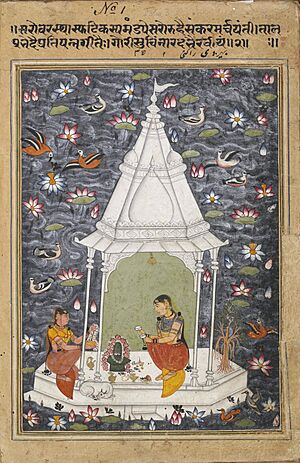Gouache facts for kids
Gouache (pronounced gwahsh) is a special kind of paint. Many people also call it poster paint. It is made from pigment (the color), a binding agent like gum arabic, and other things that make it thick and opaque. Opaque means you cannot see through it.
Often, a white powder like chalk is added to gouache. This helps it cover up anything underneath. Unlike watercolours, which are see-through, gouache is designed to be solid and block out what's below.
Contents
What is Gouache Made Of?
Gouache paint has three main parts. First, there are the pigments. These are tiny colored powders that give the paint its color. Second, there is a binding agent. This is usually gum arabic, which is a natural gum from acacia trees. The binder holds the pigment particles together. It also helps the paint stick to the surface you are painting on.
Third, gouache contains other things to make it special. These often include an inert (non-reactive) white pigment, like chalk. This makes the paint opaque. It means that when you paint with gouache, it completely covers what is beneath it. This is different from watercolours, which are transparent and let light pass through.
How to Use Gouache Paint
Gouache is very versatile. You can use it in many ways. It dries quickly, which makes it great for painting outdoors. Artists often call this "en plein air" painting. The famous artist J. M. W. Turner loved to use gouache for his outdoor sketches.
Once gouache paint dries, you can paint over it with almost any other type of paint. You can even use pastels or crayons on top of a dried gouache layer. If you use watercolours over a dried gouache surface, they won't spread out as much as they would on plain paper. This gives you more control over your watercolours.
Gouache is also popular because it can be used thickly or thinly. You can add water to make it more fluid, like watercolour. Or you can use it straight from the tube for a thick, matte finish. This makes it a favorite for illustrations and designs.
History of Gouache
Gouache has been used for hundreds of years. Artists in ancient Egypt used similar opaque paints. In Europe, gouache became popular in the Middle Ages for illuminating manuscripts. These were handwritten books with beautiful drawings.
Later, in the 18th and 19th centuries, gouache was widely used by landscape artists. They liked its quick-drying nature for capturing scenes outdoors. Today, gouache is still used by illustrators, designers, and fine artists around the world. It is a very important part of art history.
Images for kids
See also
 In Spanish: Gouache para niños
In Spanish: Gouache para niños





